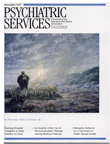Customer Satisfaction and Self-Reported Treatment Outcomes Among Psychiatric Inpatients
Abstract
OBJECTIVE: Relationships among different dimensions of patient satisfaction and selected demographic, clinical, and outcome variables were explored in a sample of severely ill people receiving inpatient psychiatric services. METHOD: The sample consisted of 81 patients admitted to and discharged from an inpatient psychiatric unit at a midwestern Veterans Affairs medical center. Stepwise multiple regression was used to examine the relationship between patient satisfaction and self-reported changes in quality of life, symptomatology, and level of functioning as measured by the Treatment Outcome Profile. Other variables such as diagnosis, length of stay, employment, living situation, and prior psychiatric and substance abuse treatment were also considered. A subsample of the most satisfied and dissatisfied patients was chosen to further explore variables contributing to satisfaction with services. RESULTS: Patient satisfaction was related to initial level of functioning, certain diagnoses, and treatment gains. Clinicians were highly accurate in identifying patients who were satisfied, based on blind chart reviews. CONCLUSIONS: This study underscores the significant relationships between patient satisfaction, psychiatric diagnosis, and other outcome measures, and argues for the validity and utility of patient satisfaction measures in assessing the efficacy of inpatient care.



